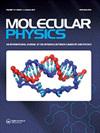Occurrence state and nuclear magnetic resonance relaxation characteristics of confined water in quartz nanopores
IF 1.8
4区 化学
Q4 CHEMISTRY, PHYSICAL
引用次数: 0
Abstract
AbstractWater in the shale obstructs the enrichment and transportation of shale gas, so it is crucial to identify the occurrence mechanism of water in shale. In this work, molecular dynamics (MD) simulation had been performed to explore the occurrence state, dynamic characteristics, and nuclear magnetic resonance (NMR) relaxation properties of confined water in shale inorganic nanopores (quartz). The results show that the number of adsorbed layers, diffusion coefficients (D) and rotational correlation time (τc) of water in quartz pores are strongly influenced by pore width (H). Layer analysis of water held in confinement indicates that the D value increases and the τc value decreases as the water approaches the centre of the pore. Furthermore, varying occurrence states lead to different NMR relaxation mechanisms. With the increase of H, the transverse relaxation time of adsorbed water is basically stable at 10−1 s. Finally, an exponential formula for evaluating pore size distribution is established. The total thickness of the water layer with the ratio of the intramolecular relaxation rate to the total relaxation rate less than 40% is defined as the thickness of the adsorbed water film.KEYWORDS: Quartz nanopores; confined water; occurrence state; nuclear magnetic resonance AcknowledgementThis research was financially supported by the Natural Science Foundation of Shandong Province (ZR2022MA052), the Independent Innovation Research Program of China University of Petroleum (East China) (22CX03004A), and the National Natural Science Foundation of China (42174142).Disclosure statementNo potential conflict of interest was reported by the author(s).Additional informationFundingThis work was supported by National Natural Science Foundation of China: [Grant Number 42174142]; Natural Science Foundation of Shandong Province: [Grant Number ZR2022MA052]; the Independent Innovation Research Program of China University of Petroleum (East China): [Grant Number 22CX03004A].石英纳米孔中承压水赋存状态及核磁共振弛豫特征
页岩中水阻碍了页岩气的富集和输运,因此明确页岩中水的赋存机制至关重要。本文通过分子动力学(MD)模拟研究页岩无机纳米孔(石英)中承压水的赋存状态、动态特征及核磁共振弛豫特性。结果表明,石英孔隙中水的吸附层数、扩散系数(D)和旋转相关时间(τc)受孔隙宽度(H)的影响较大。禁闭水的层间分析表明,随着水逐渐接近孔隙中心,D值增大,τc值减小。此外,不同的赋存状态导致不同的核磁共振弛豫机制。随着H的增加,吸附水的横向弛豫时间基本稳定在10−1 s。最后,建立了评价孔径分布的指数公式。定义分子内弛豫率与总弛豫率之比小于40%的水层总厚度为吸附水膜的厚度。关键词:石英纳米孔;承压水;赋存状态;本研究得到山东省自然科学基金项目(ZR2022MA052)、中国石油大学(华东)自主创新研究计划项目(22CX03004A)和国家自然科学基金项目(42174142)的资助。披露声明作者未报告潜在的利益冲突。本研究由国家自然科学基金资助:[批准号:42174142];山东省自然科学基金项目[批准号ZR2022MA052];中国石油大学(华东)自主创新研究计划[批准号:22CX03004A]。
本文章由计算机程序翻译,如有差异,请以英文原文为准。
求助全文
约1分钟内获得全文
求助全文
来源期刊

Molecular Physics
物理-物理:原子、分子和化学物理
CiteScore
3.60
自引率
5.90%
发文量
269
审稿时长
2 months
期刊介绍:
Molecular Physics is a well-established international journal publishing original high quality papers in chemical physics and physical chemistry. The journal covers all experimental and theoretical aspects of molecular science, from electronic structure, molecular dynamics, spectroscopy and reaction kinetics to condensed matter, surface science, and statistical mechanics of simple and complex fluids. Contributions include full papers, preliminary communications, research notes and invited topical review articles.
 求助内容:
求助内容: 应助结果提醒方式:
应助结果提醒方式:


